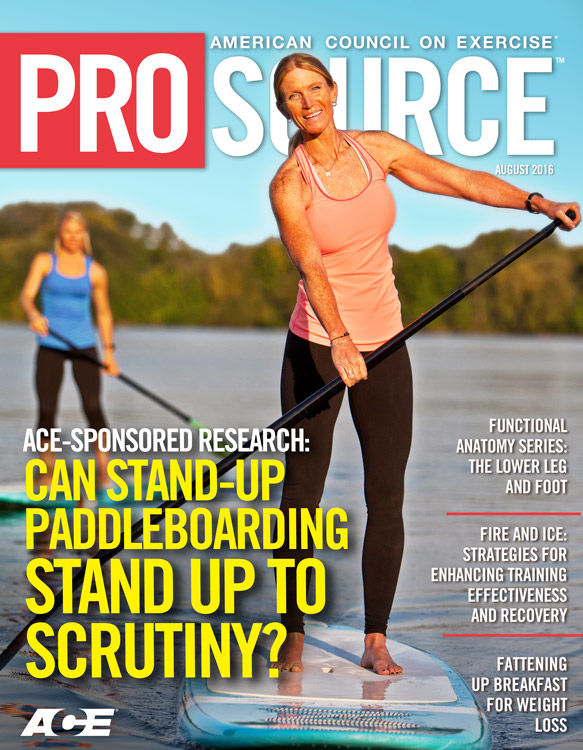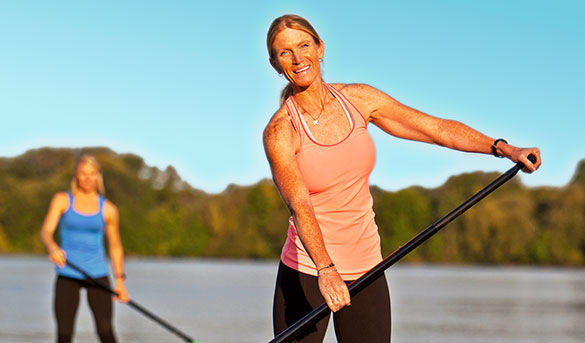
Stand-up paddleboarding (SUP) originates from modes of transport used by ancient cultures in Africa and South America and made its way to Southern California via the Hawaiian Islands in the early 2000s. Since then, this highly enjoyable activity has spread across the country. In addition to its growing popularity on the coasts, it’s not unusual to see packs of paddleboarders traversing rivers all over the nation’s interior. In addition, there are festivals, races and professional competitions that celebrate and help expand the popularity of the sport.
Anecdotal reports from SUP enthusiasts suggest that participants derive many benefits from participating in the sport, including increased muscle strength, core conditioning, enhanced balance and improved cardiorespiratory conditioning.
The core workout comes from the constant need to maintain balance on an ever-shifting surface via contractions in the abdominal and other core muscles. Because there is limited data to support these claims, ACE enlisted a team of researchers led by John Porcari, Ph.D., at the University of Wisconsin–La Crosse to determine if the core muscles are sufficiently activated during stand-up paddleboarding to provide a training benefit.
For the second study into the physiological effects of SUP, ACE enlisted the help of Jeanne Nichols, Ph.D., and her team of researchers at the University of California, San Diego, to determine and compare cardiorespiratory responses and the energy cost of SUP in both novice and experienced paddlers under laboratory and on-water conditions.
Study #1: Core Muscle Activation During Stand-up Paddleboarding
Autumn Vogel, B.S., John P. Porcari, Ph.D., Maria L. Cress, M.S., Clayton Camic, Ph.D., Attila Kovacs, Ph.D., Kimberly Radtke, M.S., and Carl Foster, Ph.D.
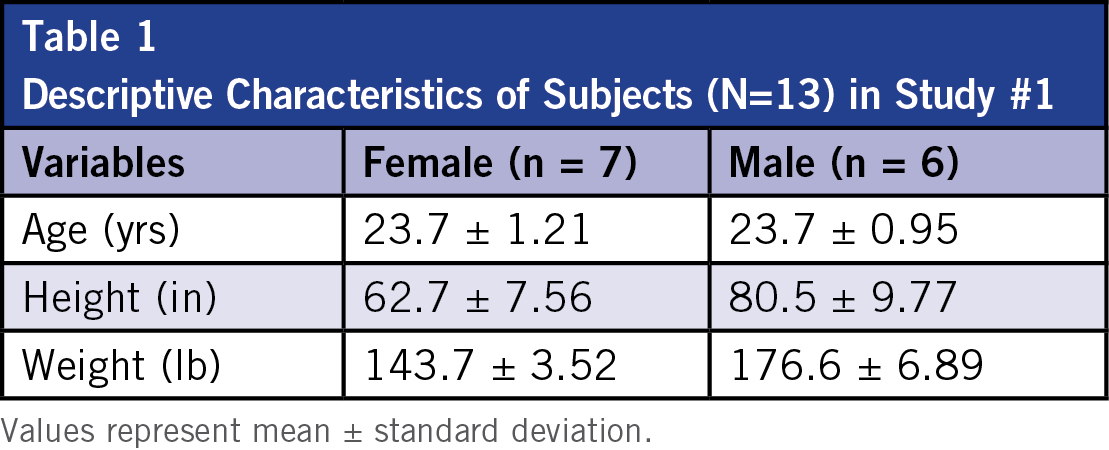
For this study, researchers recruited 13 apparently healthy volunteers (six men and seven women) between the ages of 21 and 25 years, all of whom had experience with SUP (Table 1). After some practice sessions, participants completed a round of testing during which electromyography (EMG) electrodes were placed on three muscles of the core (Figures 1 and 2):
- Rectus abdominis
- External oblique
- Erector spinae
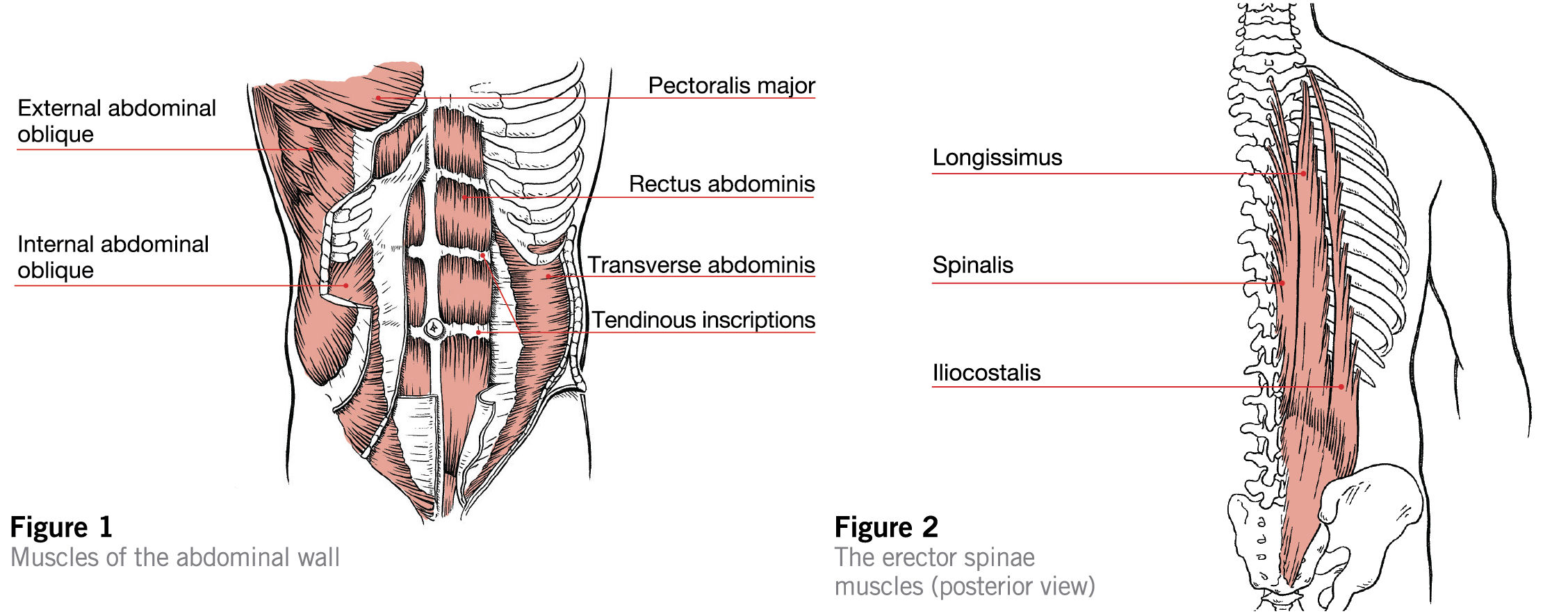
To begin, subjects were asked to perform an exercise targeting each of the three muscles to elicit a maximal voluntary contraction against which the results of the SUP session could be compared.
The researchers had to be creative in putting together a SUP experience that mimicked the real world and yet allowed them to collect the data they were seeking. The SUP sessions were conducted in the steeplechase pit at the university track. Participants paddled on a 10½-foot surfboard with the leg strap attached to two weighted slides. This served to keep the paddleboard in the center of the pit and provided resistance against which the subjects could paddle (Figure 3).
After becoming familiar with the set-up, each participant was asked to determine an intensity that elicited a rating of perceived exertion (RPE) of 11, 13 and 15 (6 to 20 scale). They then paddled at each of those levels (in ascending order) for bouts of 30 seconds.

The Results
Previous research concluded that muscle activity above 45 percent of the maximal voluntary contraction (%MVC) should result in strength improvements (Ekstrom, Donatelli and Carp, 2007). The EMG results for each of the muscles tested were as follows:
- Rectus abdominis: Above this threshold at all RPE levels (Figure 4)
- Erector spinae: Above this threshold at all RPE levels (Figure 5)
- External obliques: Above this threshold only at an RPE of 15 (Figure 6)
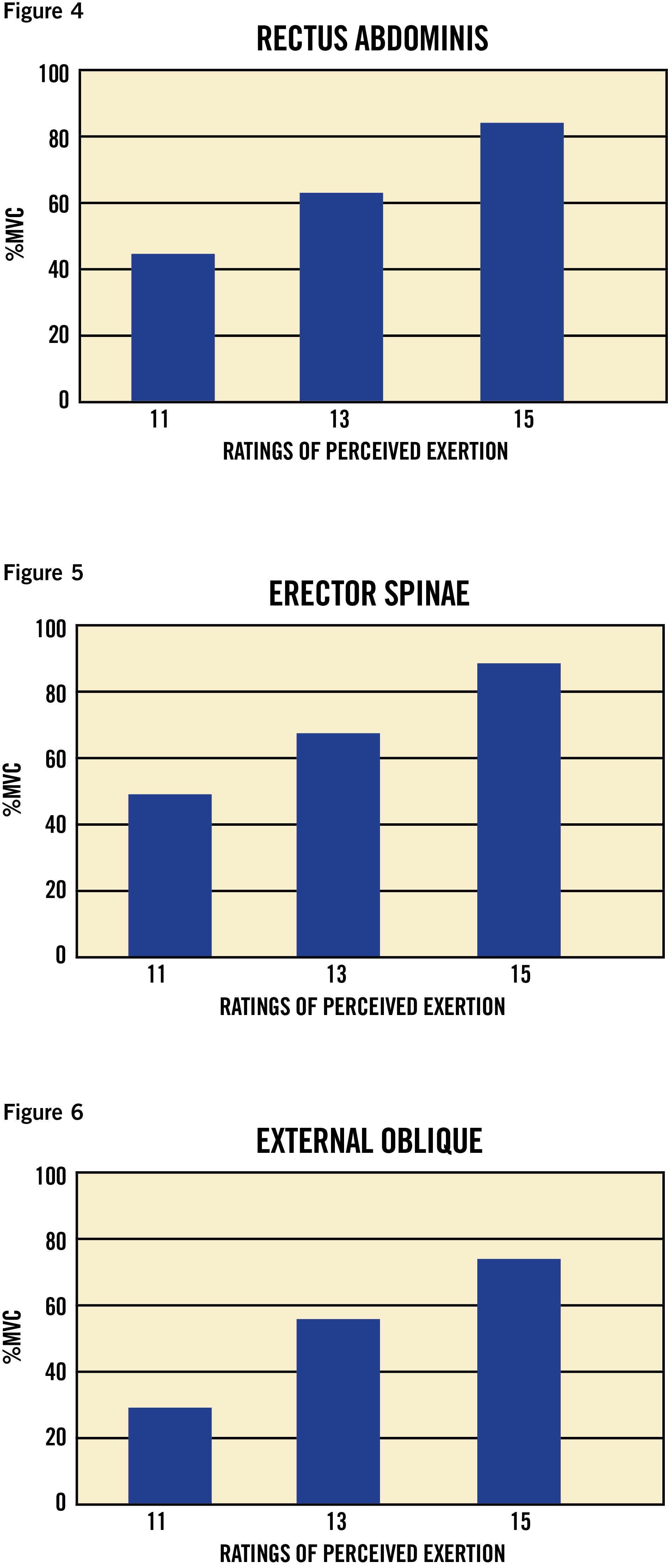
The Bottom Line
The results of this study indicate that SUP provides a sufficient stimulus to strengthen the erector spinae and rectus abdominis at RPEs of 11 and above, while the external obliques were only adequately stimulated when the RPE reached 15. The researchers speculate that the higher intensity needed to stimulate the external obliques may be due to a greater need to twist the core to propel the board at a faster pace. According to Dr. Porcari, when the subjects increased their intensity to an RPE of 15, more twisting was evident in their performance, which is an indicator of good form during SUP. “The ability to turn the shoulders and really dig in to create torso rotation,” says Dr. Porari, “creates more power in the paddle stroke and better recruitment of the external obliques.”
Study #2: Stand-up Paddling for Fitness and Caloric Expenditure: What Does the Research Show?
Alison Meagher, B.S., Danica Ito, M.S., David Wing, M.S., and Jeanne F. Nichols, Ph.D., FACSM
Twenty paddlers (equally divided so that there were five men and five women in both the novice and experienced groups) between the ages of 21 and 51 were recruited to participate in this study.
The first element of this study featured a laboratory assessment conducted using a SUP ergometer. Metabolic and cardiorespiratory responses were measured using a chest-mounted portable breath-by-breath metabolic system. The on-water session was performed on calm water in a Southern California bay. Participants wore a downloadable sport watch to measure heart rate (HR). In addition, researchers tracked the distance paddled by each subject.
Two separate studies were conducted in the lab. After a three-minute warm-up, participants were asked to complete a 100-meter paddle multiple times, with each interval being 10 seconds faster than the previous one. Peak oxygen uptake (VO2peak) and peak heart rate (HRpeak) were collected. After 15 minutes of rest, participants began three five-minute steady-state exercise bouts corresponding to 45 percent (light intensity), 60 percent (moderate intensity) and 75 percent (high intensity) of their peak power output attained during the 100-meter intervals. VO2, HR and power output (in Watts) were measured continuously throughout each bout of exercise.
While on the water, the participants performed two 250-meter time trials, the first at a leisurely pace and the second after being told to go “as fast as possible.”
Energy expenditure was determined directly from VO2 measured during the steady-state bouts in the lab, while during the on-water trial it was estimated using regression equations.
The Results
The participants’ physical characteristics and cardiorespiratory fitness variables are presented in Table 2.
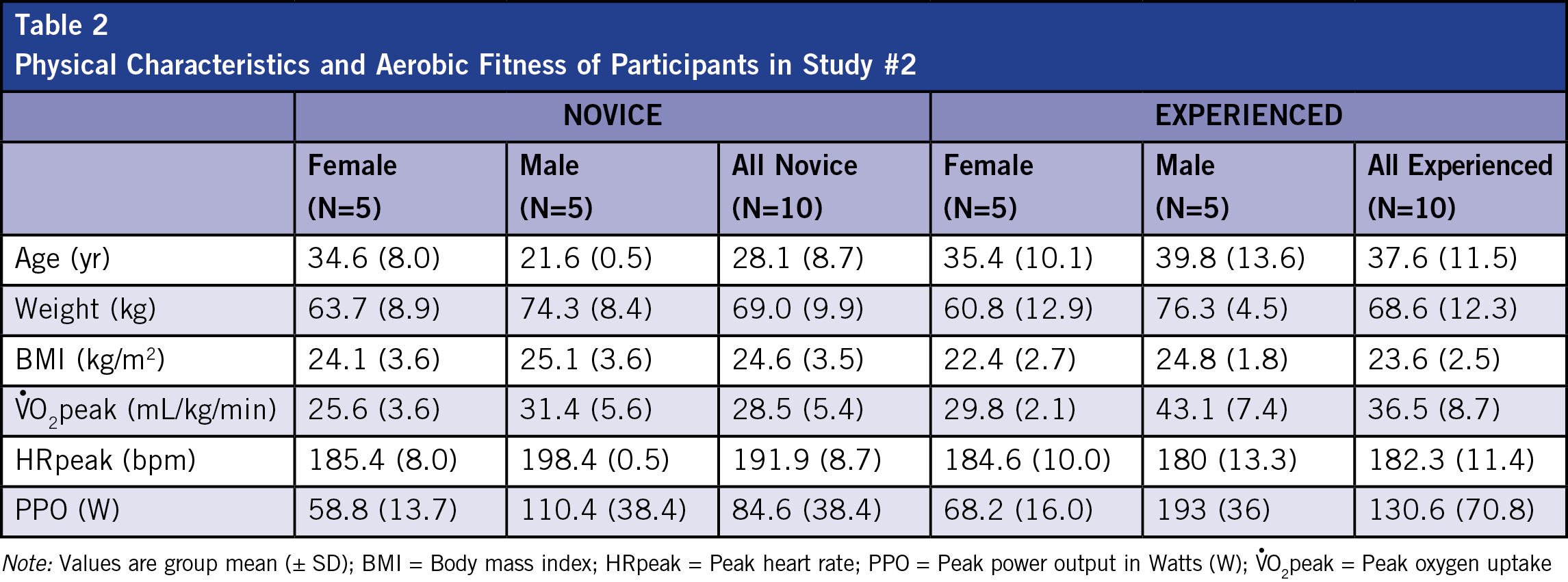
Lab results of HR and energy expenditure while paddling at power outputs of 45 percent, 60 percent and 75 percent of peak power output are shown in Table 3.
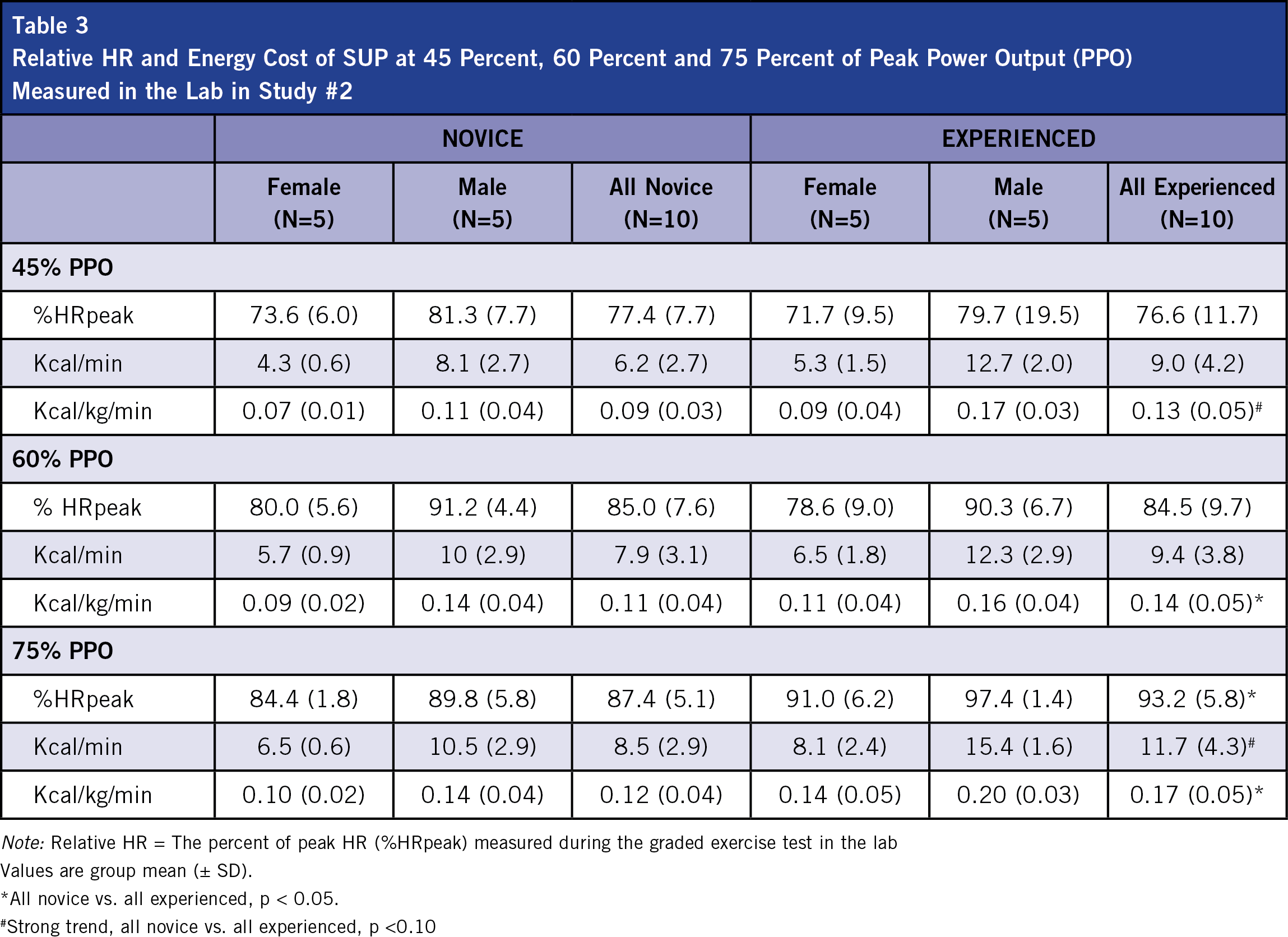
The results of the on-water trials are reported in Table 4. Compared to the novice paddlers, experienced participants paddled 21 to 24 percent faster and at a higher relative HR during both the leisurely and fast-paced trials.
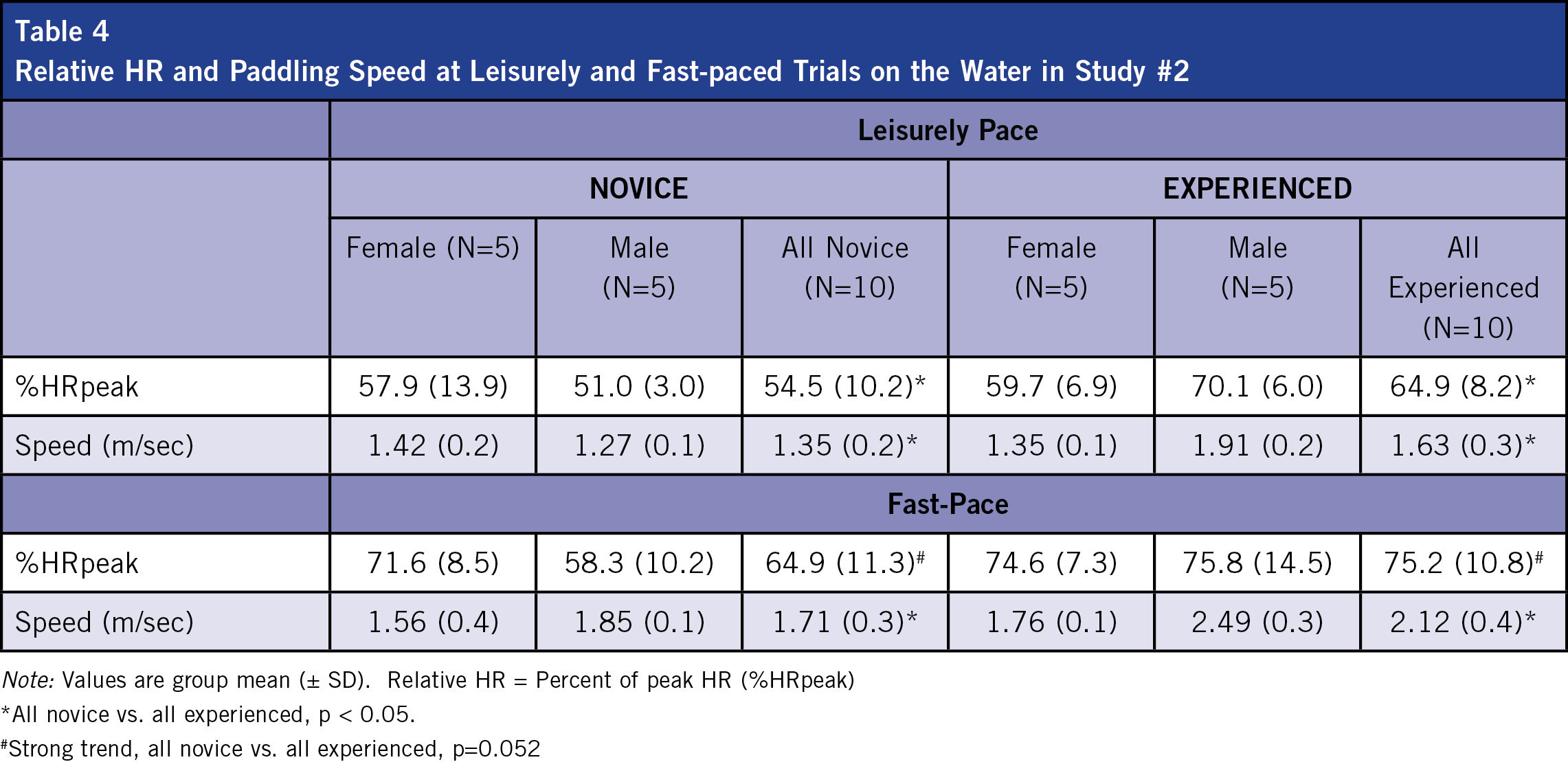

Physiological Responses to Stand-up Paddleboarding
Jessica Andres, B.S., John P. Porcari, Ph.D., Maria L. Cress, M.S., Clayton Camic, Ph.D., Kimberly Radtke, M.S., and Carl Foster, Ph.D.
Dr. Porcari and a second team of researchers from University of Wisconsin–La Crosse conducted what he says is the first study to directly measure VO2 during paddleboarding.
For this study, the researchers recruited 16 apparently healthy college-aged individuals (eight men and eight women) who regularly participated in recreational activity. After practicing SUP until they were considered proficient, subjects completed three trials of SUP at RPE values of 11, 13 and 15 (6 to 20 scale). For each trial, participants paddled for three minutes to reach steady-state exercise, and expired air was collected during the last 30 seconds of each trial. HR was recorded at the end of each trial, and speed was averaged over three speedometer readings during each trial.
The purpose of this study was to determine the energy cost and HR responses to the three bouts of SUP at varying intensities. At an RPE of 11, the men and women worked at 69 and 71 percent of predicted MHR, and the intensity increased along with RPE. These results indicate that SUP at an RPE of 11, 13 and 15 are within established industry recommendations for moderate- to vigorous-intensity exercise.
In terms of energy expenditure, the research team calculated that, among the men in this study, 30-minute exercise bouts at RPEs of 11, 13 and 15 would yield calorie burns of 312, 369 and 507 kcal, respectively. The women would see values of 228, 282 and 327 kcal for those same workouts.
The results of this study suggest that SUP meets established industry guidelines for improving cardiorespiratory endurance and positively affecting body composition. Exercising at RPE levels of 11 to 13 would appear to be most appropriate for recreational SUP, as the relative exercise intensity at RPE level 15 fell into the very vigorous range.
A key finding of this study was that, at a self-selected leisurely pace on the water, the novice paddlers fell short of reaching the HR threshold of 64 percent of maximal HR (MHR) known to elicit positive cardiorespiratory adaptations (American College of Sports Medicine, 2014). The average HR of the novice paddlers was 55 percent of MHR. In addition, the average HR of the novices during the fast-paced trial was only 65 percent of MHR, which is just above that threshold.
However, in the lab, these same novice paddlers achieved an average HR ranging from 77 to 87 percent of their MHR, well within the 64 to 94 percent range identified by ACSM, during the three bouts of simulated paddling at predetermined work rates. These findings suggest that novice paddlers may be limited by skill or comfort level while on the water, which is to be expected.
Somewhat surprisingly, the average HR of the experienced paddlers did not exceed 75 percent of MHR during the fast-paced trial on the water, even though they were instructed to paddle at top speed. That said, there was a large degree of variability seen within each group of paddlers, meaning that while some were below the training threshold, others paddled at, or even exceeded, the upper end of the desirable training range.
Energy expenditure in the lab ranged from 0.09 to 0.12 kcal/kg/min and from 0.13 to 0.17 kcal/kg/min for novice and experienced paddlers, respectively, during the three rounds of simulated paddling. For novice paddlers, this translates to 185 to 250 kcal burned during a 30-minute workout. Experienced paddlers can expect to expend 270 to 300 kcal during a 30-minute workout. A consistent exercise intensity is assumed for both groups.
Using the average on-water HR values and an average body weight of 152 lb (69 kg), novice paddlers could expect to burn only about 60 to 125 kcal during a 30-minute session at a self-selected leisurely to fast pace, while experienced paddlers would burn 150 to 199 calories in that same scenario.
The Bottom Line
Distinct differences in HR and energy expenditure were observed between simulated paddling on a SUP ergometer and “real-life” paddling on the water, and these differences were somewhat greater among novice paddlers. This may reflect a lack of skill and/or confidence on the water. The average relative HR of the novice paddlers in this study during on-water paddling did not meet established industry guidelines for maintaining and improving cardiorespiratory fitness. However, as a paddler becomes more comfortable on the water and improves paddling technique, he or she will begin to get an increasingly better workout.
Dr. Nichols points out that SUP is a safe and highly enjoyable activity, a feeling shared by the study participants. “The water provides a considerable balance challenge that was not duplicated in the lab setting,” says Dr. Nichols. “As you overcome that challenge and begin to focus on better technique and higher speeds, the caloric expenditure increases. I also think it’s important to acknowledge the fact that the value of getting outdoors and having fun while being physically active cannot be overstated.”
In Conclusion
Participating in SUP can be a fun and unique alternative to traditional cardiovascular endurance sports such as jogging, biking and swimming. It also provides adequate muscle stimulation to provide a core-training workout and a substantial balance challenge. Many people may find SUP to be a more accommodating form of exercise than running or walking due to the low-impact mechanisms of the sport. In addition, SUP is a sport suitable for all ages, as well as for people with lower-body orthopedic problems that inhibit them from running or even walking comfortably.
One important note: While the results of Study #2 showed that novice paddlers did not achieve an adequate heart rate for SUP to be considered moderate-intensity exercise, Dr. Nichols points out that the novices in this study were told to paddle at a self-selected “leisurely pace,” and that perhaps they were a bit cautious. “Their limitations,” says Dr. Nichols, “may have been as much about skill level and comfort as about fitness.” Dr. Porcari echoes this sentiment, saying that “the more proficient you are on the water—or in any type of workout, for that matter—the better the workout you will get.” Both researchers remind us that there is great value in leisurely exercise and getting outdoors, but if you are using SUP as a means of achieving a good workout, you have to paddle with intent.
Perhaps most importantly, according to everyone involved in these studies, SUP is a lot of fun—and finding enjoyable physical-activity experiences for clients can be a driving factor in long-term adherence and true lifestyle change.
Reference
American College of Sports Medicine (2014). ACSM's Guidelines for Exercise Testing and Prescription (9th ed.). Philadelphia: Wolters Kluwer/Lippincott Williams & Wilkins.
Ekstrom, R.A., Donatelli, R.A. and Carp, K.C. (2007). Electromyographic analysis of core, trunk, hip, and thigh muscles during nine rehabilitation exercises. Journal of Orthopaedic & Sports Physical Therapy, 37, 12, 754–762.





 by
by 